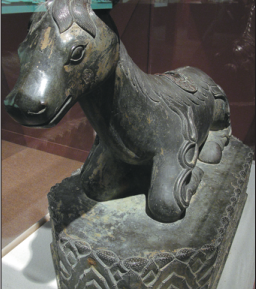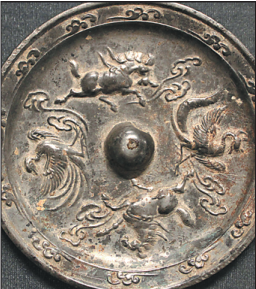
|
 |
|
A pair of horse statues that adorned the Juren Hall show the impact of Western sculpture.[JIANG DONG/CHINA DAILY]
|
A Tang dynasty bronze mirorr features a pair of flying horses and a pair of phoenixes as decoration.[CHINA DAILY] |
Of all the 12 Chinese zodiac animals, the horse is the animal that the people feel the greatest connection to.
Even though nowadays horses are rarely used on farms or for transport and certainly not as a battle companion, people still relish the excitement of galloping on horseback. And the rich cultural history of the relationship between horses and people make the animals a recurring motif in artworks today.
The Capital Museum is holding a horse-themed exhibition. The noble, gentle creatures are represented in many different forms, such as paintings and statues of jade, ceramic and bronze.
A sancai (three-colored) terracotta horse of the Tang Dynasty (AD 618-907) is an example of how statues of horses were often included in tombs. Its role as a symbol of wealth and social rank lasted for several centuries. Carriages were found in nobles' tombs dating as far back as the Shang Dynasty (c.16th century–11th century BC).
The horse represents bravery and power in Giuseppe Castiglione's signature work, Emperor Qianlong at a Military Review. In the original painting on silk, the Qing Dynasty (1368-1911) court painter from Milan, portrayed the 29-year-old emperor in a suit of splendid armor and his horse. Castiglione used Chinese brushwork though he hadn't quite mastered ink techniques at that time. He gave the work a pleasant three-dimensional effect of an oil painting.
The museum has a life-sized replica of the emperor and his horse measuring 3.3 meters in height. Qianlong's face has been removed, allowing visitors to stand in his place for photos.
The horse also looks cute enough to be petted, despite it being only a bronze ornament.
Another item on display is a pair of seated horses that adorned the Juren Hall inside the Zhongnanhai compound. Originally named Haiyan Hall, the two-story hall in the Western style was accomplished in 1904. It was where Empress Dowager Cixi played hostess to foreign female guests.
"The horses exude a royal demeanor of grace and possess the realistic touch of Western sculpture," says Zhang Jie from the museum's curatorial and research department.
A similar approach is also represented in a set of eight miniature ceramic horses. They are in different poses-running, scratching, turning and lowering their heads. And they wear heart-melting expressions of either innocence, curiosity or laziness. At merely 4 to 5 centimeters high, they reflect the sophisticated craftsmanship of the Minguo period (1911-49).
This year, the museum's calendar encompasses magnificent examples of imperial art, trade culture and manufacturing history from home and abroad, says Long Xiaofei, head of the museum's curatorial and research department.
Two exhibitions will reflect upon the history of the Maritime Silk Road and the Silk Road in April and August. The display of hundreds of antiques from seven seafront provinces and cities and five provinces in Northwest China show some of the culture that sprung up around the business between East and West over several centuries.
The National Museum of Cambodia will bring relics of the Angkorian period in a showcase of the Khmer empire's incredible artistic legacies. The Palace Museum will loan its collections of paintings, furniture and artifacts from the Ningshou Palace, showing some of the mystery and inner world of Qing Emperor Qianlong.
A grand timepiece exhibition in May will trace the evolution of watch and clock making in Switzerland from the late Middle Ages. A lineup of 250 timepieces, original design manuscripts and instruments from Vacheron Constantin's corporate collections and the Geneva-based Museum of Clocks and Mechanical Instruments will be on display.
The Capital Museum, which encapsulates Beijing's cultural and historical heritage, will curate an exhibition to celebrate Beijing's time-honored brands during the APEC Beijing Summit.
"We presented 27 exhibitions last year and together with eight permanent display sections, received more than 1.3 million viewers," says Guo Xiaoling, director of the Capital Museum. "The museum houses some 200,000 antiques, and we are uploading their details and images online to follow the trend of going digital."
IF YOU GO
9 am-5 pm, closed on Mondays, until March 23.
Capital Museum, 16 Fuxingmenwai Dajie (Street), Xicheng district, Beijing.
010-6337-0491/2.
We recommend:
